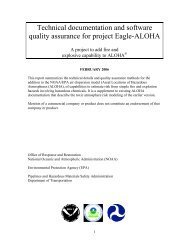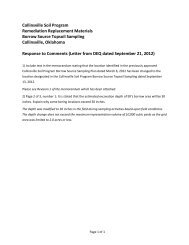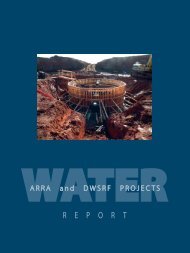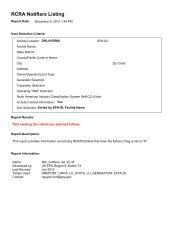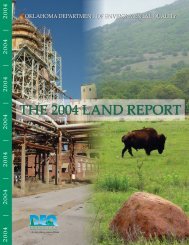Oklahoma Gas & Electric Muskogee Generating Station Best ...
Oklahoma Gas & Electric Muskogee Generating Station Best ...
Oklahoma Gas & Electric Muskogee Generating Station Best ...
You also want an ePaper? Increase the reach of your titles
YUMPU automatically turns print PDFs into web optimized ePapers that Google loves.
<strong>Oklahoma</strong> <strong>Gas</strong> & <strong>Electric</strong><br />
<strong>Muskogee</strong> <strong>Generating</strong> <strong>Station</strong> – BART Determination<br />
May 28, 2008<br />
technology on any large subbituminous coal-fired boilers. However, other than scale-up<br />
issues, there do not appear to be any overriding technical issues that would exclude<br />
application of the control technology on a large subbituminous coal-fired unit.<br />
Assuming that the JBR-WFGD control system is commercially available for <strong>Muskogee</strong><br />
Units 4 & 5, the JBR is essentially a wet FGD scrubbing system. Unlike the spray tower<br />
systems, where the scrubbing slurry contacts the flue gas in a countercurrent reaction tower,<br />
in the JBR-WFGD flue gas is bubbled through the limestone slurry. SO2 in the flue gas<br />
reacts with the limestone slurry to form insoluble calcium sulfate and calcium sulfite,<br />
which is removed as a solid waste by-product. Although the reaction vessel used to contact<br />
flue gas with the scrubbing slurry uses a different design, the reaction chemistry to remove<br />
SO2 from the flue gas is the same for all wet FGD designs.<br />
There are no data available to conclude that the JBR-WFGD control system will achieve a<br />
higher SO2 removal efficiency than a more traditional spray tower WFGD design,<br />
especially on units firing low-sulfur subbituminous coal. Furthermore, the costs associated<br />
with JBR-WFGD and the control efficiencies achievable with JBR-WFGD are similar to<br />
the costs and control efficiencies achievable with spray tower WFGD control systems.<br />
Therefore, the JBR-WFGD will not be evaluated as a unique retrofit technology, but will be<br />
included in the overall assessment of WFGD controls.<br />
Dual-Alkali Wet Scrubber<br />
Dual-alkali scrubbing is a desulfurization process that uses a sodium-based alkali solution<br />
to remove SO2 from combustion exhaust gas. The process uses both sodium-based and<br />
calcium-based compounds. The sodium-based reagent absorbs SO2 from the exhaust gas,<br />
and the calcium-based solution (lime or limestone) regenerates the spent liquor. Calcium<br />
sulfites and sulfates are precipitated and discarded as sludge, while the regenerated sodium<br />
solution is returned to the absorber loop.<br />
The dual-alkali process requires lower liquid-to-gas ratios then scrubbing with lime or<br />
limestone. The reduced liquid-to-gas ratios generally mean smaller reaction units, however<br />
additional regeneration and sludge processing equipment is necessary.<br />
The sodium-based scrubbing liquor, typically consisting of a mixture of sodium hydroxide,<br />
sodium carbonate and sodium sulfite, is an efficient SO2 control reagent. However, the<br />
high cost of the sodium-based chemicals limits the feasibility of such a unit on a large<br />
utility boiler. In addition, the process generates a less stable sludge that can create material<br />
handling and disposal problems.<br />
41



